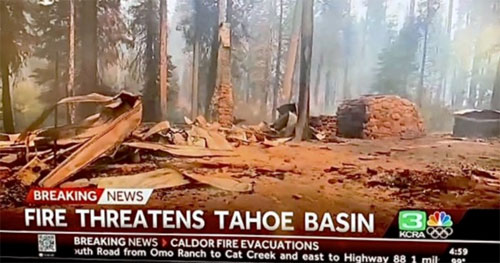Forest Fire /ESA Memo, Last Straw: Part 2
By: Amos S. Eno
Posted on:08/13/2024This morning (30 July 2024), I read Tim Stewart’s USOGA post, which got me thinking while swimming laps. As a non-lawyer, I apologize for the following ruminations. I have been telling political leaders for years that ESA is one of the largest Gordian knots needing unraveling at the Interior, and today, in western states, catastrophic forest fires and ESA have become bedmates through the midwifery of the Spotted Owl and Clinton’s Northwest Forest plan. My thoughts focus on how to unravel this mess of thirty years, preferably by executive action.
First, here are Tim’s notes on NEPA:
Climate activists are figuring out that they have created a monster with NEPA reviews
One of the good things to come from the passage of the Infrastructure Investment and Jobs Act and the Inflation Reduction Act is that these laws were passed with fanfare and modeling about how quickly we should see decarbonization of the electric grid and the economy. However, like almost all White Tower models, the academics who created them had no idea how difficult it is to build things in the real world. But they are learning!
Robinson Meyer, who writes a newsletter dedicated to climate, wrote an op-ed in the New York Times explaining how bad the permitting situation is for electricity transmission. He explains how it has taken 20 years to build the SunZia powerline in New Mexico and Arizona and how it will take three different studies for the Department of Energy to help subsidize new power lines—which is supposed to be a sped-up process.
Meyer's piece is great because he can speak to people who don’t trust those of us “tainted” by oil and gas interests. We have been saying for decades that NEPA and other permitting are a real problem, and left-wing activists have told us that all NEPA does is collect information and that collecting information to make informed decisions is not bad. Information is good, but most of the time, the information collection is a pretext for slow walking and making it harder to finance projects.
NEPA continues to be a problem for oil and gas
Dear Congressional Staffer Friends,
When you really want to do something, please use the phrase “notwithstanding any other provision of law.” Even that is not perfect all the time, but it reduces the chances a judge will stop the thing you want to do.
Thank you,
Tim
So, what’s the background for this? In the Trump administration's 5-year offshore leasing plan, there was a planned lease sale in the Cook Inlet in Alaska. The Trump administration finished the NEPA reviews and signed a Record of Decision before the end of the administration but did not have time to hold a lease sale. The Biden administration then refused to hold the lease sale until Senator Manchin required that the lease sale be held as part of the Inflation Reduction Act (I’m pretty sure Manchin included the lease sale, but I don’t know 100%).
The IRA was signed into law on August 16, 2022, and then the lease sale was required to be conducted before the end of the year. Kicking and screaming, the Biden administration held the lease sale. After the lease sale, Earthjustice, NRDC, and other environmental plaintiffs sued the Department of Interior, arguing that the NEPA requirements had not been met. This week, a judge in Alaska nominated by President Obama agreed with the plaintiffs and suspended the lease pending additional environmental reviews.
This is a bad decision. If Congress said that the Record of Decision was good enough, it should be good enough. There was no way that the Department of Interior could have done a new analysis between August and December, so Congress obviously meant to deem NEPA as complete. I think this decision will be overturned, but it will take a while.
Again, this is how the greens want NEPA to operate. However, by slowing down oil and gas projects, they are now starting to see how it can slow down renewable and electricity transmission projects. Reap what you sow, guys.
Western Forest Fires: In addition to destroying hundreds of homes and taking human lives, western fires are destroying more wildlife habitats and individual species, such as the spotted owl, than any other manmade cause of species mortality. California’s Park Fire is now threatening spring-run Chinook salmon, already in the midst of a population crash, by burning through upper Mill and Deer Creek watersheds. Although the media and environmental organizations blame global warming, this is demonstrably a charade. Western fires are a manmade catastrophe caused by fifty years of no forest management caused by environmental restrictions combined with the co-existent building of fuel loads in an ecosystem of millennial fire-adapted forests. Environmental litigants are the principal deterrent to forest management with their weekly/monthly suits to prevent both USFS and BLM from exercising remedial forest management using both NEPA and ESA as legal cudgels. I have had several conversations with my board member, Attorney Jonathan Brightbill, seeking any potential for class action litigation against environmental litigants, but he has assured me that both First Amendment and case law based on current environmental statutes place environmental litigants in an unchallengeable position through the courts. That being the case legally, how do you turn off the environmental litigant spigot when they, in fact, are destroying our forests, killing vulnerable species, endangering communities, and putting local lumber businesses Malheur Lumber closed 30 July, the fifth Oregon lumber company to close mills in 2024. These out-of-business closures remove both boots on the ground and forest management capacity from forest fire control and amelioration across the rural West.
Former forester Bob Zybach recently wrote (2 July 2024) in Oregon’s Rogue Valley Times that “environmental lawsuits are killing people. Oregon has been conflagrated most summers from June to October since 1987…the 2002 Biscuit fire was 500,000 acres in size, the Kalmiopsis Wilderness has now burned four times… the 2020 Labor Day Fires killed 11 people in southwest Oregon and burned more than 4,000 homes…according to National Library of Medicine research from 2007-to 2020 more than 11,000 U.S. deaths per year from long-term effects of wildfire smoke…a University of California study of smoke-related mortality from 2008-2018 estimated 52,000 to 56,000 Californians suffered premature death due to wildfire smoke inhalation.” He concludes: “Our ancestors showed us how to fix this problem. Stopping these costly lawsuits by environmentalists is key. Restoring active management of our public roads, trails, and forests will mostly end these deadly events and also provide jobs and income needed to restore our rural schools, industries, communities, and clean, healthy air.” As of 2 Aug.2024, 120 fires are burning in Oregon, with 1.1 million acres scorched. The irony here is rich indeed. While the environmental movement has demonized the oil and gas industry for over 40 years, the greenies are the responsible party for incinerating John Muir’s CA and Oregon forests and all other western states, including WA, ID, MT, NV, UT, CO, AZ, and NM. And now, the same legal tools they have been using to stymie forest management and oil/gas infrastructure. Are impeding their beloved intermittent power projects. Rich indeed, hanging on their own petard.
Remedial congressional legislation such as Cong. Westerman/Peters’s bill, FIX OUR FORESTS ACT, is necessary but will take years to implement policy changes. Environmental litigants are awash in funding from Global Warming financiers. The chart below is from Steve Moore, Committee to Unleash Prosperity.

* Initiate an Interagency study/report on species loss, particularly endangered species mortalities, habitat loss, water contamination, and detrimental carbon release caused by western forest fires: USGS, USFS, USFWS BLM, and Bu Rec. This should be disseminated to political leadership and both federal and state courts.
* Engage the private sector for solutions. Komodo is a new CA fire suppression company. TANZLE (www.tanzle.com), through the Cal ALERT initiative, prevented 1000 forest fires in California in 2023 through the deployment of robotic sensors and AI-propelled alert and communication systems to CAL Fire. Their technology is immediately applicable to all western states and capable of identifying and reacting to wildfires on a scalable basis.
* Create a mission priority program through USFS State and Private Forestry (SPF) to help sustain and reinvigorate western community forest products mills. In the last week of July, two mills closed in Oregon, Western Cascades Industries in Toledo, OR, on the west side, and Malheur Mill in John Day on Oregon’s east side. Montana has also seen multiple mill closures in the last six months.
* Make Trump campaign/administration PR priority to pin the tail of the donkey on environmental litigants as the principal cause of forest fires endangering both the environment and human communities. Leadership reaches out to donors of environmental groups to suppress funding and create private-sector remediation. Additionally, as mentioned in my previous post introducing the AFF film, Congress needs to end environmental litigants seeking to impede aggressive forest management practices by passing NO INJUNCTION legislation. Congress has done this before, so there is precedent in the face of national emergencies with labor with the passage of the Norris LaGuardia Act in 1932.
* In concert with Western Caucus, Evergreen Foundation, Nadine Bailey (Family Water Alliance), Michael Rains (A CALL TO ACTION), Family Farm Alliance, NCBA, etc., promote grassroots initiative to combat environmental litigants’ war on rural forest and ranch communities.

* Engage Insurance and Utility sectors (PGE, Pacific Corp, BH) in targeted and coordinated responses to environmental litigants. A July 12, 2024 article in Nevada Globe by Dana Tibbitts headlines: “UNDER FIRE: The escalating crisis of USFS Fire Policy in the West has insurance companies more risk averse than federal firefighting agencies. Through the opening salvo of another red-hot fire season, another cloud of calamity is rearing its ugly head: INSURANCE COMPANIES RUNNING FOR THE DOOR, DROPPING POLICYHOLDERS LIKE HOT POTATOES …Travelers Insurance reported in a recent filing in California: “It is critical to the success of our business that we reduce our exposure to wildfire catastrophic losses”… State Farm has just delivered a brutal ultimatum: Authorize another round of rate increases, or we’re out. This second round of on-demand rate hikes this year, 30% for homeowner policies, has millions of shell-shocked residents in California and Nevada over a barrel and legislators running for cover.”
 Sign In
Sign In
 Sign In
Sign In
